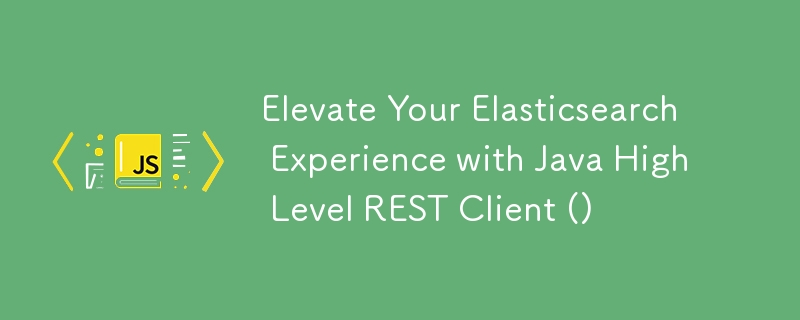使用 Java 進階 REST 用戶端提升您的 Elasticsearch 體驗 ()
- PHPz原創
- 2024-07-18 09:01:00691瀏覽

介紹
Java High Level REST Client (7.x) 是一個與 Elasticsearch 叢集互動的強大工具,使伺服器通訊更容易存取和高效。在本指南中,我們將引導您完成在阿里雲 Elasticsearch 叢集上使用進階 REST 用戶端呼叫 Elasticsearch Java API 的步驟。
準備工作
步驟1:建立Elasticsearch集群
確保您的叢集版本與您計劃使用的 Java High Level REST Client 版本相同或更高。有關逐步說明,請參閱建立阿里雲 Elasticsearch 叢集。
第 2 步:啟用自動索引
在 YAML 設定檔中啟用自動索引功能。詳情請參閱設定YML檔。
步驟3:設定IP位址白名單
透過設定IP位址白名單確保正常通訊。如果您透過 Internet 存取集群,請依照設定公用或私人 IP 位址白名單中的指南允許來自所需 IP 位址的請求。
第四步:安裝JDK
安裝 Java 開發工具包 (JDK) 1.8 或更高版本。有關更多信息,請參閱安裝 JDK。
步驟5:建立Java Maven項目
將必要的依賴項新增至您的 pom.xml 檔案中。將相依性中的版本號碼從 7.x 變更為您正在使用的進階 REST 用戶端的特定版本。
<dependency>
<groupId>org.elasticsearch.client</groupId>
<artifactId>elasticsearch-rest-high-level-client</artifactId>
<version>7.x</version>
</dependency>
<dependency>
<groupId>org.apache.logging.log4j</groupId>
<artifactId>log4j-core</artifactId>
<version>2.20.0</version>
</dependency>
<dependency>
<groupId>org.apache.logging.log4j</groupId>
<artifactId>log4j-api</artifactId>
<version>2.20.0</version>
</dependency>
範例:管理索引
以下是使用進階 REST 用戶端建立和刪除索引的範例。將佔位符 {} 替換為您的特定參數。
import org.apache.http.HttpHost;
import org.apache.http.auth.AuthScope;
import org.apache.http.auth.UsernamePasswordCredentials;
import org.apache.http.client.CredentialsProvider;
import org.apache.http.impl.client.BasicCredentialsProvider;
import org.apache.http.impl.nio.client.HttpAsyncClientBuilder;
import org.elasticsearch.action.delete.DeleteRequest;
import org.elasticsearch.action.delete.DeleteResponse;
import org.elasticsearch.action.index.IndexRequest;
import org.elasticsearch.action.index.IndexResponse;
import org.elasticsearch.client.*;
import java.io.IOException;
import java.util.HashMap;
import java.util.Map;
public class RestClientExample {
private static final RequestOptions COMMON_OPTIONS;
static {
RequestOptions.Builder builder = RequestOptions.DEFAULT.toBuilder();
builder.setHttpAsyncResponseConsumerFactory(
new HttpAsyncResponseConsumerFactory
.HeapBufferedResponseConsumerFactory(30 * 1024 * 1024));
COMMON_OPTIONS = builder.build();
}
public static void main(String[] args) {
final CredentialsProvider credentialsProvider = new BasicCredentialsProvider();
credentialsProvider.setCredentials(AuthScope.ANY,
new UsernamePasswordCredentials("{Username}", "{Password}"));
RestClientBuilder builder = RestClient.builder(new HttpHost("{Endpoint of the Elasticsearch cluster}", 9200, "http"))
.setHttpClientConfigCallback(new RestClientBuilder.HttpClientConfigCallback() {
@Override
public HttpAsyncClientBuilder customizeHttpClient(HttpAsyncClientBuilder httpClientBuilder) {
return httpClientBuilder.setDefaultCredentialsProvider(credentialsProvider);
}
});
RestHighLevelClient highClient = new RestHighLevelClient(builder);
try {
Map<String, Object> jsonMap = new HashMap<>();
jsonMap.put("{field_01}", "{value_01}");
jsonMap.put("{field_02}", "{value_02}");
IndexRequest indexRequest = new IndexRequest("{index_name}", "_doc", "{doc_id}").source(jsonMap);
IndexResponse indexResponse = highClient.index(indexRequest, COMMON_OPTIONS);
long version = indexResponse.getVersion();
System.out.println("Index document successfully! " + version);
DeleteRequest deleteRequest = new DeleteRequest("{index_name}", "_doc", "{doc_id}");
DeleteResponse deleteResponse = highClient.delete(deleteRequest, COMMON_OPTIONS);
System.out.println("Delete document successfully! \n" + deleteResponse.toString());
highClient.close();
} catch (IOException ioException) {
ioException.printStackTrace();
}
}
}
高並發配置
針對高並發場景,增加客戶端連線數:
httpClientBuilder.setMaxConnTotal(500); httpClientBuilder.setMaxConnPerRoute(300);
範例程式碼片段:
String host = "127.0.0.1";
int port = 9200;
String username = "elastic";
String password = "passwd";
final int max_conn_total = 500;
final int max_conn_per_route = 300;
RestHighLevelClient restHighLevelClient = new RestHighLevelClient(
RestClient.builder(new HttpHost(host, port, "http")).setHttpClientConfigCallback(new RestClientBuilder.HttpClientConfigCallback() {
public HttpAsyncClientBuilder customizeHttpClient(HttpAsyncClientBuilder httpClientBuilder) {
httpClientBuilder.setMaxConnTotal(max_conn_total);
httpClientBuilder.setMaxConnPerRoute(max_conn_per_route);
return httpClientBuilder.setDefaultCredentialsProvider(credentialsProvider);
}
})
);
有關功能和配置的更多詳細信息,請參閱官方 Java 高級 REST 客戶端文件。
結論
使用 Java High Level REST Client 可確保與阿里雲 Elasticsearch 叢集高效互動。按照本指南充分利用您的 Elasticsearch 設定。
準備好開始阿里雲上的 Elasticsearch 之旅了嗎?探索我們量身訂製的雲端解決方案和服務,將您的數據轉變為視覺傑作。
點擊此處開始 30 天免費試用
以上是使用 Java 進階 REST 用戶端提升您的 Elasticsearch 體驗 ()的詳細內容。更多資訊請關注PHP中文網其他相關文章!

